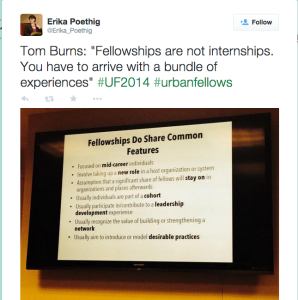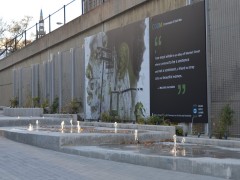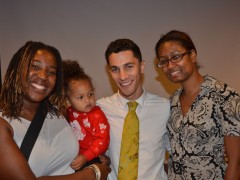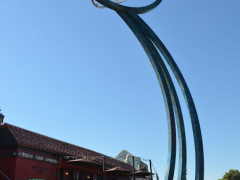The roots of urban fellowships in the United States go back to the establishment of national programs such as National Urban Fellows and local initiatives such as the New York City Urban Fellows in 1969, as well as international organizations that include fellowships, notably the German Marshall Fund of the United States (founded in 1972). These programs focus on leadership development, social change, and a distinctly personal engagement in the challenges and needs of cities, primarily within or aligned to the capacity of city governments.
Since the early 2000s, urban fellowships have received renewed attention and investment, through such locally sponsored programs as Capital City Fellows (CCF), established in 2000 in Washington, D.C.; and the Detroit Revitalization Fellows (DRF), established in 2011 with generous support from numerous foundations. The energetic leadership of philanthropists, universities, and the federal government have been a hallmark of 21st Century fellowship programs, from the Center for Urban Redevelopment Excellence (CUREx) at the University of Pennsylvania (2003-2006, supported by the Knight Foundation) to the federal Strong Cities Strong Communities (SC2) initiative (2012-2014), established by the Obama White House and carried out through the U.S. Department of Housing and Urban Development, with key support from The German Marshall Fund’s Urban and Regional Policy Program and Surdna Foundation.

The four urban fellowship programs that are the focus of this site (CUREx, CCF, DRFP, and SC2) share several traits in common. As summarized by Katy Locker of The Knight Foundation from a talk given by Tom Burns of the Urban Ventures Group, this “next wave” of urban fellowship tend to
- Allow fellows to serve host employers full time
- Build or strengthen a network of fellows and host organizations
- Develop leadership skills
- Focus on mid-career individuals
- Focus on a specific issue, practice area, or place
- Gather fellows as a mutually supportive cohort
The focus on mid-career professionals in the urban fellowship programs studied here also drives several important secondary traits:
- Level of service and access to leadership: Urban fellows in mid-career expect to have autonomy, decision-making power, and direct access to strong leaders in the cities they serve. The Capital City Fellows program, for example, offers participants their own budgets and teams during three 6-month rotations in three different agencies during their tenure. See “Where Are They Now? Capital City Fellows.”
- Length of service, compensation, and commitment going forward: Mid-career fellows need to have adequate time in a host city, and compensation for their experience. Cities benefit from a sustained increase in capacity by offering such stability to fellows, rather than just a temporary surge for a year or months-long commitment. During the CUREx program, for example, placements lasted two years and annual salaries were $60,000. Capital City Fellows currently offers about $54,000 in salary, with an opportunity for a performance increase during the second year.
- Mentoring and networks of peers: Presumedly, talented mid-career practitioners make the leap to an urban fellowship for its growth potential, and have every reason to expect strong mentoring, new skills, and peers who will become close colleagues and friends over a lifetime career. Example of mentoring/networking support from one of the programs from both DRFP and SC2.
READ ON: Where are urban fellows placed?





Leave a Reply